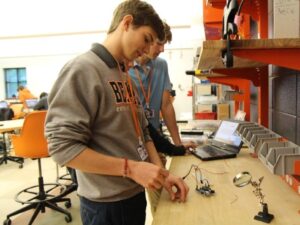In the spring of 2016, Catholic High School (CHS) had a STREAM dream–to develop a curriculum that would take the standard STEM approach (science, technology, engineering and mathematics) and raise it to the next level by developing and incorporating relevant religion and art classes into the course selection. The objective was to provide students with a holistic, hands-on learning approach to the skills and fields of engineering. Nearly four years later, that dream has become a reality and an important tool in equipping CHS students with the knowledge and skill sets to be successful in college and beyond.
Implemented in the 2017-2018 school year, the CHS STREAM program is a four-year series of elective classes designed to work in tandem with CHS’s college preparatory curriculum. “Without trying to interrupt the curriculum as it is, we wanted to develop a sequence of courses that examine how multiple disciplines worked together in the field of engineering,” says Jared Cavalier, CHS academic assistant principal. Students who complete the STREAM program credit requirements receive a special certificate at graduation.
Beginning with the ninth grade year, the school developed an Introduction to Engineering Design class with a companion Media Arts I class. These two classes work together to give students a basic overview of the engineering process and focus on planning and design. As part of the requirements, students must create an engineering sketch book for their projects. “Engineers need to be well-rounded,” noted Cavalier. “They need to be able to research, write, and draw – there is an element of art in everything they design.”
After completing the introductory courses, students who want to continue the specialized track have the option to take more advanced classes as sophomores. The Principles of Engineering course is a survey class designed to introduce students to the different areas of engineering. It builds on the previous concepts of planning and design, but incorporates a more hands-on project based approach. Students work with levers and pulleys, build a small-scale working elevator and even design a robot. Because of the foundation laid in the freshman year, students have a better sense of how to design and approach these kinds of projects. “Students have a broader perspective of what they are trying to achieve–a bigger picture of how to approach the problem, and that influences the design and construction process of the potential solution,” says Cavalier.
As juniors, students begin to select specific areas of engineering based on their interests and goals. The Civil Engineering and Architecture class challenges students with real-world problems and encourages them to create viable solutions. Students design and build model homes, focusing on areas of energy efficiency and sustainable construction materials. They also tackle larger problems like drainage and responsible community planning. In addition, students learn the techniques and skills involved in land surveying through hands-on surveying projects around campus.
Aerospace Engineering is another class option during the junior year. Exploring the concepts of engineering and physics behind flight, students design and build rockets as well as balsa wood airplanes. Using the classroom’s wind tunnel, students tweak their designs for better results. “They put the planes in the wind tunnel and blow smoke over it to look at the aerodynamics of the design,” notes Cavalier. “From there, they can determine which airfoil design has the best lift and make the proper adjustments.”
The senior year of the CHS STREAM program culminates with a capstone class designed to utilize the skills and concepts learned from previous courses. Modeled after LSU’s senior level engineering class, Engineering Design and Development, is an honors course that begins by highlighting the different engineering disciplines and the challenges professionals face in each of those fields. Then, breaking into small groups of 4-6 students, each group identifies a problem in the area of engineering that interests it, and creates a solution for that problem. Eli Bacilla, the course’s instructor, guides the students through the process. “Students spend the majority of the course going through the engineering design process–starting with concept generation, brainstorming, cost analysis and finally developing their device in the embodiment design phase,” says Bacilla. To assist them with the project, students learn how to use real-world engineering tools such as decision matrices, Pugh Charts, Gantt Charts and CAD modeling. In addition to the engineering skills students learn through these projects, they also learn to develop life-skills. “Students have to develop communication skills through teamwork and presentations, as well as learn how to prepare technical reports and project notebooks,” notes Bacilla.
One of the goals of the CHS STREAM program is to incorporate the disciplines of art and religion to enhance the traditional STEM approach. As a result, the school developed Faith, Science and Humanity–a religion companion class to Engineering Design and Development. In this course, seniors are introduced to the concept of ethical engineering and social justice. “We want our students to understand and realize how their talents can be used to renew God’s creation and not just to make money,” says Cavalier. “We want them to see the bigger picture. We want to instill a mindset that will guide them in identifying problems and creating solutions for the greater good of society and mankind.”
While the STREAM program is still relatively young, there is no denying its popularity and success. Twenty-seven members of the Class of 2020 completed the program requirements and received the CHS STREAM Certificate. There were approximately 290 students across the grade levels who were enrolled in engineering classes in 2019-2020, and nearly 65 percent of last year’s freshman class took the Introduction to Engineering course. With these numbers, the school is excited about the future of the program. “We are certainly headed in the right direction with this program. As the fields of engineering evolve, we will continue to develop and improve the STREAM program to ensure our students are learning and applying the concepts and skills needed to be competitive in this industry,” concludes Cavalier.





